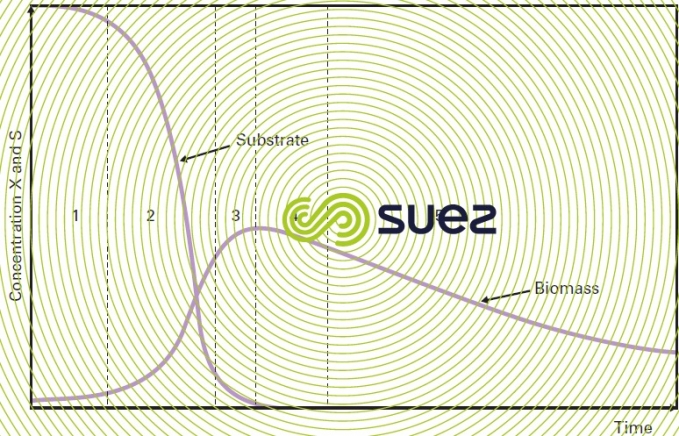development of a bacterial culture
Reading time:After seeding and providing that it has the right environment, a bacterial culture will continue to develop until it has exhausted its nutrient medium. Figure 1 has been prepared for constant conditions (temperature, pH...) and represents the variations in a bacteria culture concentration (X) and in its substrate (S) where the culture develops as a function of time in an intermittent reactor. The process goes through a number of phases:
lag phase (phase 1)
During this adaptation phase, the cell will specifically synthesise the elements required for substrate metabolisation. This phase is important when the water has not previously been seeded with suitable germs. No cell reproduction takes place during this phase.
exponential growth phase (phase 2)
During this phase, growth rate dX/dt increase in direct proportion to X:


Where μm is the maximum growth rate (typical of the culture and of the substrate) that will be maintained while there is sufficient substrate.



slowing down phase (phase 3)
This is the phase during which the culture medium becomes depleted, causing the disappearance of one or more of the elements required for bacterial growth. X will continue to increase whereas dX/dt will decrease. In some cases, the slowing down phase may also be due to the accumulation of inhibitor products resulting from the bacterial metabolism itself.
stationary phase (phase 4)
X reaches its maximum value Xmax. Overall growth ceases, even when cells maintain a metabolic activity. The cells slowly exhaust their intracellular reserves and as they die, the synthesis balances out.
death phase (also known as the endogenous phase) (phase 5)
The living cell concentration decreases as the cells die at an increasingly high rate. This mortality is caused by the cells’ enzymatic autolysis.
These different phases together with the relevant equations apply to both aerobic and anaerobic environments. Clearly, the value attributed to the different coefficients will depend on the nature of the micro-organisms, of the substrate and of various parameters (temperature, pH, presence or absence of dissolved O2).
Bookmark tool
Click on the bookmark tool, highlight the last read paragraph to continue your reading later












